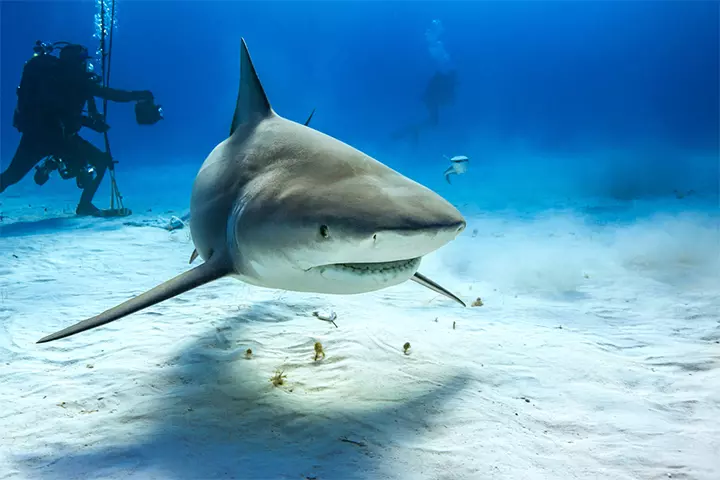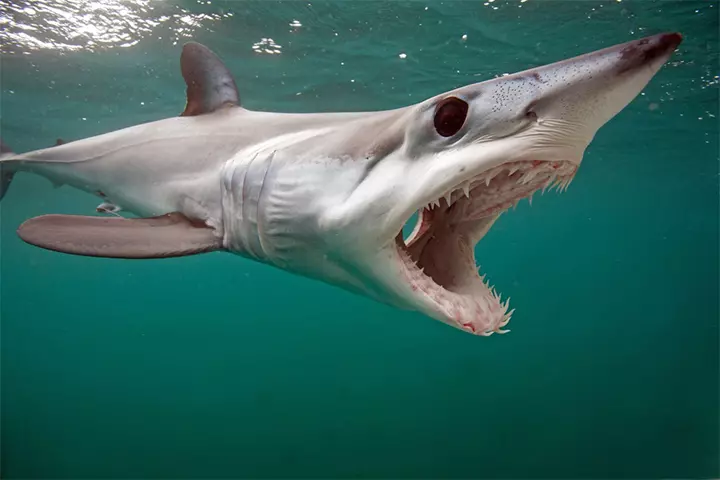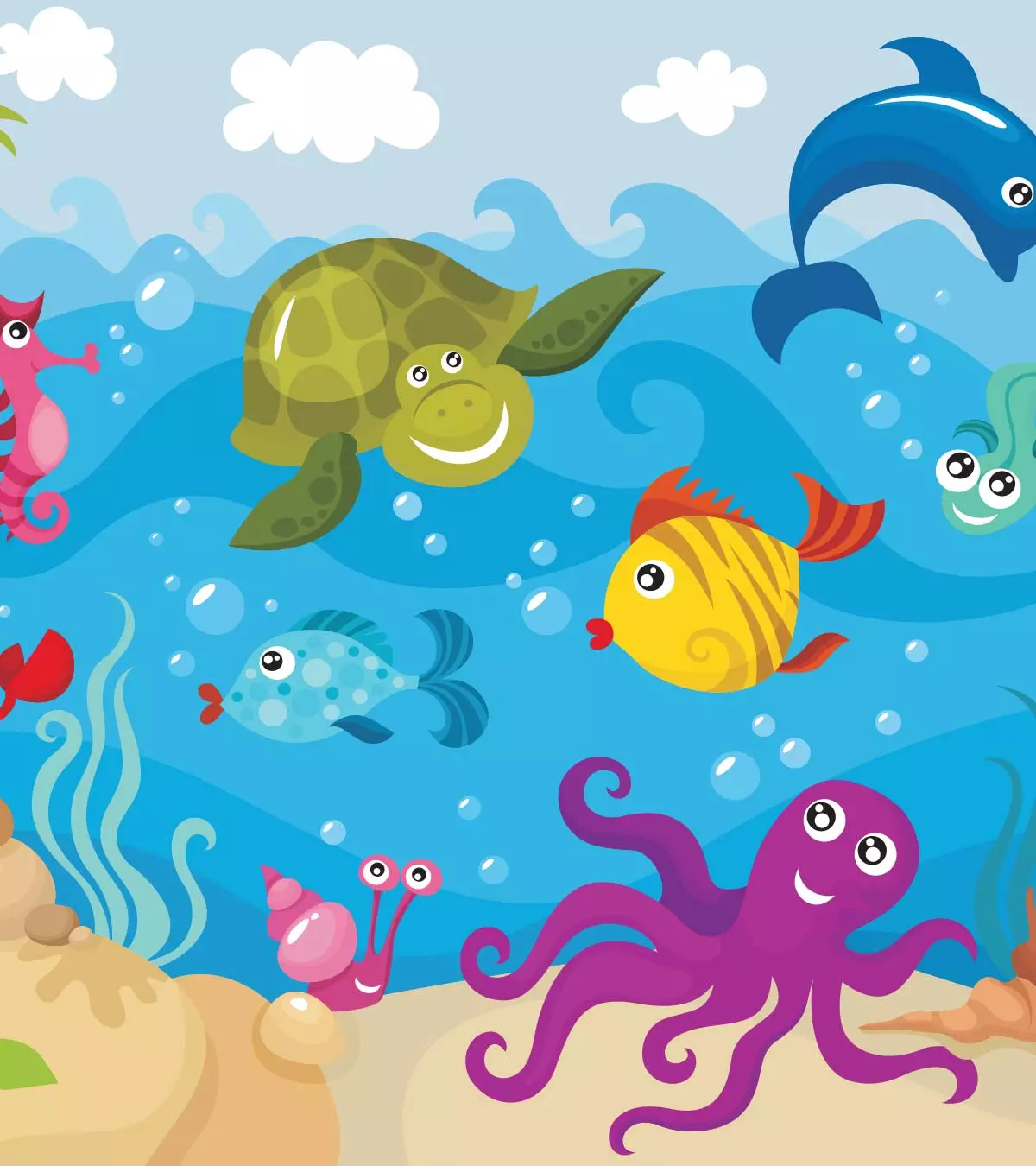
Image: Shutterstock
Sharks are fascinating underwater creatures that captivate children’s imaginations. However, some could find them scary. Sharing interesting shark facts for kids can help them appreciate this larger-than-life creature. Sharks are among the oldest animals on Earth that have outlasted dinosaurs. These unique creatures have endured for 400 million years and evolved to build a diverse ecosystem in our oceans. By preying on the elderly and ill, they help prevent the spread of illnesses and preserve a healthy gene pool. Introduce your child to the world of sharks, and teach them some fascinating facts about these aquatic wonders.

Key Pointers
- Sharks contribute significantly to the finely balanced ecosystems that support the health of our seas.
- The great white shark, bull shark, hammerhead shark, whale shark, and mako are just a few of more than 500 different shark species worldwide.
- With many shark populations diminishing due to environmental changes and intentional and unintentional overfishing, the ecological balance may be affected. It is time we grow aware.
Types Of Sharks
The top predators in the ocean have evolved into more than 500 species with a wide range of sizes, colors, feeds, and behaviors. Here is a list of some popular types of sharks:
1. Greenland shark
The Greenland shark, or Somniosus microcephalus, is the world’s longest-living vertebrate. According to scientists, the Greenland shark has an estimated lifespan of at least 250 years. They might live for more than 500 years. The average length of this giant, heavy-set shark is eight to 14 feet, but it may grow up to 24 feet. It has small eyes, a short, rounded head, and relatively small dorsal fins. It is a slow swimmer. The flesh of the Greenland shark is poisonous when fresh but may be eaten after being dried.
2. Whale shark
Whale sharks are the largest sharks and the biggest fish. They have an almost 40-feet maximum length! Whale sharks are spotted, each with a distinct pattern of spots. They can be found in the warm waters of the Atlantic, Pacific, and Indian oceans. Despite their vast size, their diet only consists of filter feeders and tiny plankton. They may travel thousands of kilometers in search of new feeding sites but can swim only about three miles per hour. Whale sharks have a large sweeping tail, a broad, flat head, five large gill slits, and relatively tiny eyes. They have two dorsal, two long pectoral, and two pelvic fins.

3. Basking shark
The basking shark is the second-largest fish in the world. It can weigh more than 10,000 pounds and be longer than 30 feet. The mouth of the basking shark is huge! It can spread out to be up to five feet broad. It can be found worldwide in cold to moderate waters. The basking shark has a large, gray body and swims with its enormous mouth open.
4. Bull shark
These enormous sharks are known for their aggressive temperament. They stand out for their blunt nose and ability to control their bodies so they may survive in both fresh and saltwater. Bull sharks have specific glands and kidney functions that aid with salt retention in freshwater. These sharks primarily consume fish but can also consume other sharks, marine animals, birds, and turtles. These ferocious sharks can grow up to 11.5 feet long and weigh about 500 pounds. Bull sharks are probably declining since they are heavily fished for their meat, hides, and oils.

5. Great white shark
Great white sharks can be found worldwide. They adore living by calm waters and being near the coast. Great white sharks are naturally curious and are known as the most dreadful predators in the water. The world’s largest predatory fish are great whites. They can get as big as six meters long and weigh more than 4,000 pounds. Because of their superior sense of smell and good swimming abilities, these sharks can detect their prey up to two miles away. They favor eating tiny whales, seals, and sea lions.
6. Mako shark
Mako sharks are fast-swimming ferocious and dangerous predators found in both tropical and temperate water. The mako shark is divided into two species – shortfin mako and longfin mako. The longfin mako is uncommon, while the shortfin mako is more common. The shortfin mako can weigh up to 1,500 pounds and reach lengths of more than 12 feet. It has five-gill holes to draw oxygen from the water. Mako sharks have exceptionally sharp, pointed teeth suited for grabbing and consuming large fish. They can even leap 20 feet in the air!

7. Thresher shark
Thresher sharks have long tails that may extend as far as the shark’s body. They utilize their long tail as a weapon to shock their victim, usually schooling fish, before spinning around to devour the confused food. They develop slowly but can grow to be 20 feet long. Its mouth and teeth are small, and its head is short and cone-shaped. They are quick swimmers and occasionally leap out of the water. However, they are harmless to humans. This family of sharks consists of three species: the Pelagic Thresher, the Bigeye Thresher, and the Common Thresher.
8. Hammerhead shark
Hammerhead sharks get their name from the shape of the head. Their large, rectangular heads are the most distinguishing feature. These sharks, which live in warm tropical waters, are scary predators. They all contain electroreceptors, which can sense signals emitted by living organisms. These receptors help them detect their preferred prey, stingrays. They also consume other sharks, squid, lobsters, crabs, and bony fish. Hammerhead sharks can swim up to 25 miles per hour and typically live for around 30 years. They have a maximum length of 20 feet and a weight of about 1000 pounds.

9. Sand tiger shark
Sand tigers are also known as gray nurse sharks, ground sharks, and spotted ragged-tooth sharks. All members of this family of creatures swim slowly with their jaws open to reveal long, slender, needle-like shark teeth. The shark is usually about 10 feet long and weighs between 110 and 661 pounds. It has coppery brown spots on its body and fins and is light grayish brown on top with a pale belly. Fish, tiny sharks, lobsters, squid, rays, and skates are among the prey of the sand tiger.
10. Blue shark
The graceful and streamlined blue sharks got their name from their metallic blue backs that serve as excellent underwater camouflage. They have small mouths and wide-open eyes. Squid and herring are their preferred foods, but they also eat turtles and whales in some situations. Blue sharks are friendly and do not attack people. Throughout their lifetimes, they are known for migration across entire ocean basins. They enjoy traveling! Blue sharks can grow up to 13 feet long; however, they are usually closer to 10 feet long.

50 Shark Facts For Kids
Here are some simple yet interesting shark facts for kids. Share them with your children to spark curiosity and encourage them to learn more about these magnificent creatures.
1. Sharks have multiple rows of teeth that are lost and regenerated endlessly throughout their lifespan (1).
2. Sharks can drastically vary in their size, ranging from the dwarf lantern shark, which is the smallest and approximately the size of a human hand, to the whale shark, which can grow to 40 feet (2) (3).
3. Although most sharks are cold-blooded, a few species, including the great white sharks, are partially warm-blooded. This characteristic may enable them to swim quickly when hunting prey (4).
4. Sharks are boneless creatures. They have a cartilage skeleton, the same tough, flexible tissue that makes up human ears and noses (5).
5. Some shark species do not produce live pups. Instead, they deposit the egg case on the seafloor, where the pup eventually hatches on its own.
6. Sharks have incredible hearing. They can hear fish in the sea from great distances (6).
7. They have sharp eyesight and can see even in low light. This helps them see their prey at night (6).
8. The spots on whale sharks are as distinctive as human fingerprints (7).
9. Sharks are believed to be older than trees. While the oldest tree lived about 350 million years ago, sharks have been alive for about 450 million years.
 Point to consider
Point to consider10. The placoid scales, often referred to as dermal denticles that make up shark skin, have a texture similar to sandpaper (8).
11. Sharks are capable of going into a trance. When turned on its back, the shark enters a trance-like state known as tonic immobility (9).
12. Some shark species have spiracles, enabling them to draw water into their respiratory system at rest. However, some others need to continue swimming to pump water over their gills (10).
13. The Pygmy shark measures about 11 inches.
14. Sharks usually give birth after an 11 to 12-month gestation period. However, some, like the frilled shark, can carry a baby for over three years (11).
15. While the other sharks can produce six to 12 young, the hammerhead and tiger sharks may have up to 40.
16. Shark Awareness Day is observed annually on July 14. The celebration encourages people to be empathetic toward marine animals (12).
17. Sharks have survived five major calamities that nearly wiped out the Earth. The last of these extinction events, some 65 million years ago, even wiped off the dinosaurs.
18. The Cladoselache is one of the earliest shark species identified (13). These 1.2-meter shark fossils date back more than 400 million years.
19. Sharks do not eat people. They are drawn to their natural prey. When sharks come in touch with people, it usually happens accidentally or because it is looking for a meal.
20. The lantern sharks have unique light-emitting organs called photophores, made of photogenic cells known as photocytes (14).
21. Shark livers are huge, accounting for about 30% of the body weight in some species. These organs provide them with energy and help with buoyancy (11).
22. Sharks usually survive 20 to 30 years if there is enough food and no predators. However, Greenland sharks may have a life expectancy of over 100 years (15).
23. The Goblin Shark is a rare deep-water species with an extended jaw that can snap and snag prey in the depths of the ocean (16).
24. Around 11 tonnes of food are consumed annually by great white sharks! Compared to humans, each of us consumes nearly half a tonne of food annually.
25. Hammerhead sharks are known to exist in nine different species, with the Carolina hammerhead shark being the most recently recognized (17).
26. There are three large filter-feeding species of sharks (they strain out small plankton from water for food). Examples of these sharks are megamouth sharks, basking sharks, and whale sharks (18).
27. Sharks’ hearts are s-shaped, having two chambers (19).
28. A whale shark has skin that is six inches thick (20).
29. Sharks don’t blink even though they have eyelids. They utilize them to shield their eyes during combat (6).
30. Sharks cannot make sounds because they lack vocal cords.
31. Scientists often use the number of rings on a shark’s vertebrae to estimate its age. However, recent research shows that this method may not always be accurate (5).
32. Sharks have a tongue-like structure called basihyal, which does not have taste buds (21).
33. Hammerhead sharks are excellent hunters because of their 360-degree vision (22).
34. Sharks are excellent swimmers, but they can only swim forward.
35. A breach is a term used to describe when a shark jumps out of the water (23).
36. Before attempting to consume their meal, sharks circle it to understand better what they have spotted.
37. Sharks consume approximately 2% of their body weight.
38. Sharks were referred to as sea dogs by seamen until the 16th century (24).
39. Shark embryos can detect danger while still in their egg sacs.
40. A baby shark is born with teeth and the ability to swim away and protect itself.
 Quick fact
Quick fact41. Whale sharks, despite their size, pose no serious threat to people. They are calm, peaceful, and occasionally curious and playful beings (20).
42. While the number of pups born in a litter varies greatly between species, some sharks can have an enormous litter. One litter from a blue shark can have up to 135 young (25).
43. Sharks can freely move their upper and lower jaws, unlike humans, who can only move their lower jaw. Therefore, when a shark strikes its food, its upper jaw separates to give it a greater grasp (26).
44. The Megalodon, a shark measuring over 50 feet in length, existed around 16 million years ago and went extinct only 1.6 million years back (21).
45. As apex predators, sharks have an immediate impact on all marine species below them in the food chain, helping to keep the ecosystem balanced.
46. Most species of shark may drown if they stop moving, as they lack the muscles to push water through their mouths and gills.
47. Male sharks have claspers, which are reproductive organs. All male sharks and rays have these organs as extensions of their pelvic fins (21).
48. Basking sharks are the largest fish in British waters, with a length of up to 12 meters (27).
49. A whale shark’s gills can take in more than 6000 liters of water every hour.
50. In July 2014, two populations of scalloped hammerhead sharks were declared endangered under the Endangered Species Act, making them the first to be protected under the statute (21).
Frequently Asked Questions
1. Are all sharks carnivores?
Most sharks are carnivorous, eating everything from fish to marine mammals such as seals and sea lions, and crustaceans. However, some consume specific foods; for example, the whale shark, the largest fish in the sea, eats only tiny plankton, while the bonnethead shark receives some of its sustenance from seagrass, a sort of underwater plant.
2. How high can a shark jump?
Most shark species do not breach the surface of the water. However, a few species can jump out of the water to a maximum height of 10 to 15 feet.
4. What is the difference between a shark and a dolphin?
Sharks have cartilaginous skeletons, gills, and rough skin covered in scales. Dolphins, on the other hand, are mammals and have lungs and breathe air. Additionally, their body shapes differ, with sharks typically having sleek torpedo-like shapes, while dolphins have more elongated and fusiform bodies. For more details, you can share dolphin facts for kids with your little one to satiate their curiosity.
5. How do sharks breathe?
Sharks employ their gills to initiate and conclude the breathing process. They extract oxygen from the water through their gills while eliminating carbon dioxide from their bodies (30).
Sharks are among the most well-known apex predators vital for marine ecology. Without them, marine population growth might get out of control. Sharks consume dead or decaying matter, preventing the buildup of organic waste on the seafloor, which promotes a healthier environment for marine life. In recent years, overfishing, climate change, and habitat destruction have threatened the shark species. So, introducing shark facts for kids is a great way to encourage them to be more aware of the ecology and protect these unique animals for a better and sustainable future.
Infographic: Most Popular Species Of Sharks
More than 500 shark species swim in fresh and saltwater worldwide, each with unique characteristics, appearances, colors, anatomies, and hunting behaviors. Learn about some of the most popular sharks through this infographic.
Some thing wrong with infographic shortcode. please verify shortcode syntax
Illustration: Fun And Interesting Shark Facts For Kids To Know

Image: Stable Diffusion/MomJunction Design Team
Learn all about sharks and explore their fascinating world in this incredible video!
References
- A shark’s infinite regeneration of teeth.
https://www.floridamuseum.ufl.edu/sharks/blog/a-sharks-infinite-regeneration-of-teeth/ - Dwarf Lantern Shark.
https://ocean.si.edu/ocean-life/sharks-rays/dwarf-lantern-shark - What is the biggest fish in the ocean?
https://oceanservice.noaa.gov/facts/bigfish.html#:~:text=The%20biggest%20fish%20in%20the%20ocean%20is%20the%20Rhincodon%20typus - Shark Biology.
https://www.wwf.org.uk/learn/fascinating-facts/sharks#:~:text=Most%20sharks%20are%20cold%2Dblooded - 12 Shark Facts That May Surprise You.
https://www.fisheries.noaa.gov/feature-story/12-shark-facts-may-surprise-you#:~:text=Sharks%20do%20not%20have%20bones.&text=They%20are%20a%20special%20type - Senses.
https://dlnr.hawaii.gov/sharks/about-sharks/senses/#:~:text=Sharks%20can%20hear%20disturbances%20in - Star-Mapping Algorithms Track Endangered Animals.
https://science.nasa.gov/mission/hubble/impacts-and-benefits/technology-benefits - Sharks FAQs.
https://www.floridamuseum.ufl.edu/discover-fish/sharks/faq/ - Tonic Immobility.
https://www.sharktrust.org/tonic-immobility#:~:text=Tonic%20immobility%20is%20a%20reflex - Fins and Swimming.
https://dlnr.hawaii.gov/sharks/about-sharks/anatomy/ - Faviel A. Lopez-Romero; (2025); Growth trajectories of prenatal embryos of the deep‐sea shark Chlamydoselachus anguineus (Chondrichthyes).
https://www.ncbi.nlm.nih.gov/pmc/articles/PMC7497067/ - Shark Awareness Day (July 14th) – A different kind of celebration in 2025.
https://galapagos.unc.edu/shark-awareness-day-july-14th-a-different-kind-of-celebration-in-2025/ - Shark Evolution.
https://www.sharktrust.org/shark-evolution - Julien M Claes; (2011); Control of luminescence from lantern shark (Etmopterus spinax) photophores.
https://www.ncbi.nlm.nih.gov/pmc/articles/PMC3187880/#:~:text=photophore%2C%20Etmopterus%20spinax- - All about sharks of Massachusett.
https://www.mass.gov/doc/color-and-learn-all-about-sharks-of-massachusetts/download - Goblin Sharks.
https://www.fws.gov/story/goblin-sharks - Great Hammerhead.
https://www.floridamuseum.ufl.edu/discover-fish/species-profiles/sphyrna-mokarran/ - Basking Shark.
https://www.floridamuseum.ufl.edu/discover-fish/species-profiles/basking-shark - Anatomy and Physiology.
https://seaworld.org/animals/all-about/sharks-and-rays/anatomy-and-physiology/ - Giants: Whale Shark.
http://www.elasmo-research.org/education/evolution/g_whale_shark.htm - Sharks.
https://ocean.si.edu/ocean-life/sharks-rays/sharks - Why is a predator perfected by millions of years suddenly unfit for the sea?
https://www.nespmarine.edu.au/news/why-predator-perfected-millions-years-suddenly-unfit-sea.html - Breaching Great White Shark on the Hunt.
https://ocean.si.edu/ocean-life/sharks-rays/breaching-great-white-shark-hunt#:~:text=It%27s%20hard%20to%20imagine%20a - Selachimorpha.
https://www.gbif.org/species/113272553 - Sharks.
https://www.gov.nl.ca/ffa/files/research-development-fdp-pdf-sharks.pdf - Shark Jaws Program.
https://www.csulb.edu/shark-lab/shark-jaws-program - Basking Shark.
https://www.marlin.ac.uk/species/detail/1438 - Shark Finning: Sharks Turned Prey.
https://ocean.si.edu/ocean-life/sharks-rays/shark-finning-sharks-turned-prey - Cookiecutter Shark.
https://www.floridamuseum.ufl.edu/discover-fish/species-profiles/cookiecutter-shark - Sharks Need Oxygen Too.
https://www.lung.org/blog/sharks-need-oxygen-too#
Community Experiences
Join the conversation and become a part of our nurturing community! Share your stories, experiences, and insights to connect with fellow parents.
Read full bio of Theresa Bertuzzi
Read full bio of Kavita Kankani
Read full bio of Deepa Thomas
Read full bio of Trisha Chakraborty


















